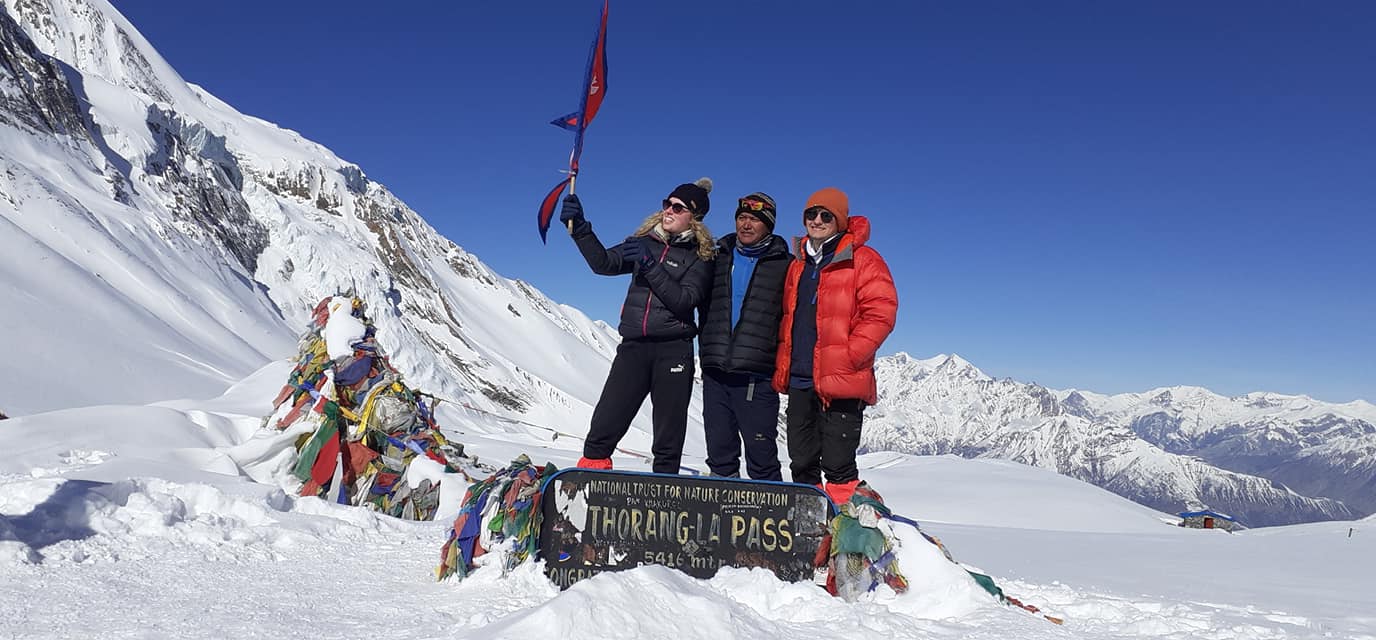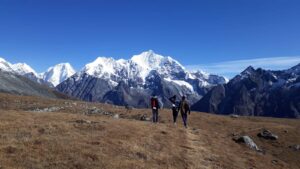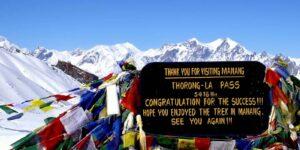
Annapurna Circuit Trek is a popular trekking route located in the Annapurna region of Nepal. It is known for its stunning mountain views, diverse landscapes, and rich cultural experiences.
The trek usually takes around 15-20 days to complete and covers a distance of approximately 160-230 kilometers (depending on the route taken). The trek starts in the town of Besishahar and follows the Marsyangdi River through lush forests, terraced farmland, and traditional villages.
The highest point on the trek is the Thorong La Pass, which sits at an altitude of 5,416 meters (17,769 feet). From the top of the pass, trekkers can enjoy breathtaking views of the surrounding peaks, including Annapurna, Dhaulagiri, and Manaslu.
Along the way, trekkers can also visit several cultural and religious sites, including the famous Buddhist monastery in Manang, the Hindu temple of Muktinath, and the ancient village of Kagbeni.
Overall, the Annapurna Circuit Trek is a challenging yet rewarding adventure that offers a unique blend of natural beauty, cultural immersion, and physical exertion.
As always for any modification of the Annapurna Circuit Treks, or any other Trek or Tour in Nepal please contact our specialist [WhatsApp: +9779851029803 Saroj] Team during your booking or via the quick inquiry.
| Activity | Distance (km) | Duration (hours) | Altitude (m) |
|---|
The Annapurna Circuit Trek is an incredibly diverse and scenic trek, with a range of highlights that make it a popular choice for adventure-seekers from around the world. Here are some of the top highlights of the Annapurna Circuit Trek:
Stunning Mountain Views: The trek offers incredible views of some of the world’s highest and most iconic peaks, including Annapurna, Dhaulagiri, Machhapuchhre, and Manaslu. Trekkers will also get to see a range of other peaks, glaciers, and valleys along the way.
Thorong La Pass: The trek reaches its climax at the Thorong La Pass, which sits at an elevation of 5,416 meters (17,769 feet) and is one of the highest mountain passes in the world. The pass offers breathtaking views of the surrounding peaks and is a challenging and rewarding achievement for trekkers.
Cultural Immersion: The Annapurna region is rich in culture and history, and the trek offers a chance to experience the local way of life firsthand. Trekkers will pass through traditional villages and meet locals from a range of ethnic groups, including Gurung, Thakali, and Manangi.
Natural Wonders: The trek takes trekkers through a range of landscapes, including lush forests, terraced farmland, alpine meadows, and high-altitude deserts. Along the way, trekkers will encounter waterfalls, hot springs, and the blue waters of Tilicho Lake.
Historic Sites: The trek includes a number of historic and religious sites, including the ancient village of Kagbeni, the Buddhist monastery in Manang, and the Hindu temple of Muktinath. These sites offer a glimpse into the rich history and religious traditions of the region.
Overall, the Annapurna Circuit Trek is a truly unforgettable adventure that offers a unique combination of natural beauty, cultural immersion, and physical challenge.
The Annapurna Circuit Trek is a challenging trek that requires a good level of physical fitness and preparation. Before embarking on this trek, it’s important to consider the following factors:
Altitude: The trek reaches elevations of over 5,000 meters, which can cause altitude sickness in some people. It’s important to acclimatize properly and be aware of the symptoms of altitude sickness.
Terrain: The trek involves a mix of steep ascents and descents, as well as rocky and uneven terrain. Trekkers should have a good level of fitness and be prepared for long days of hiking.
Weather: The weather in the Annapurna region can be unpredictable, with cold temperatures, rain, and snow possible at any time of year. Trekkers should be prepared for all weather conditions and have appropriate gear.
Accommodation: Accommodation on the trek is basic, with teahouses and lodges offering simple rooms and shared bathrooms. Trekkers should be prepared for basic living conditions.
Health: Trekkers should be in good overall health and be prepared to deal with common ailments such as blisters, cuts, and scrapes. It’s also important to be up to date on all necessary vaccinations.
Overall, the Annapurna Circuit Trek is a challenging adventure that requires physical fitness, mental stamina, and a willingness to embrace the local culture and environment. With proper preparation and a positive attitude, however, it can be an incredibly rewarding experience.
The starting point for treks in the Annapurna Region varies depending on your route. The most popular entry point is Pokhara, also known as the gateway of the Annapurna Region. This beautiful lakeside city about 200 km west of Kathmandu is regarded as the tourist hub for foreigners. From Pokhara, you can take a bus, jeep, or private vehicle to trailheads like Nayapul, Besisahar, or Kande, depending on your trek.
If you’re on a budget, local buses and shared jeeps operate from Kathmandu to Pokhara daily, which takes about 6-8 hours. Private vehicles are also available for hire, offering a more comfortable and flexible journey.
Some of the itineraries start from Besisahar for the Annapurna Circuit, while others begin at Nayapul or Kande for treks like Ghorepani Poon Hill or Annapurna Base Camp. The roads differ from well-paved highways to rough off-road tracks, especially in higher-altitude areas.
This morning, drive to Besisahar (approximately 5.5 hours) to immediately immerse yourself in the spectacular mountain wilderness that encompasses the Annapurna Range. After lunch you will begin, you will drive straight away, heading to Ngadi.
Overnight at Ngadi.

After breakfast, we walk through the villages and riverbanks of Marshyangdi River. We will take a break for our lunch and then follows the trial crossing suspension bridges, steeply uphill and forest to Chamje.
Overnight at Chamje.
After the breakfast in Chamje the trek goes through the Tal the first village of Manang District. Crossing the suspension bridges in Marshyangdi River, we will be at Dharapani after 6-7 hours of walk.
We will be staying in a guesthouse for the night.
We continue ascending through forests of pine and oak, we pass through Dhanakyu before coming to a large waterfall. Further, on, the Marshyangdi River enters a gorge and the trail follows a rock-strewn path. When the steep incline ends, we follow a path amid rhododendrons and continue on a gently rising path. We cross a stream before entering a pine forest. We then enter the hamlet of Kotho, from where we can get a good view of Annapurna II. The route reaches a large white gate with a corrugated iron roof, which is the entrance of Chame, the administrative headquarters of Manang district. There is electricity, shops, health post, post office and banks in Chame. The hot springs are a major attraction too.
Overnight at Chame.
The trail goes through the bank of the Marshyangdi Khola. On the way, we will take a break for the lunch and again start the trek for the beautiful village, Pisang.
We will be staying in a Guesthouse for the night.
You start your trek early in the morning from Pisang. You can enjoy the amazing view of the Tilicho peak and Manang Valley as you make your way along a steep ridge. You can also get a view of Annapurna IV from the plains of the Sabje Khola Valley. You cross the Marsyangdi Khola and move to the small village of Mungji. You can also see an amazing monastery at Bryaga village. Annapurna II, III, IV, Gangapurna and Tilicho Peak can be on your way. Finally, after walking for 5 hours you reach Manang village located at 3540m.
To make ourselves able for the further trek we will rest in the Manang for a day. We can hike some popular places like Bhojo Gumpa and Gangapurna Lake.
We will be staying in a guesthouse for the night.
We will enjoy our tasty meal in Manang before we start our gentle uphill climb to Yak Kharka. Our trek will be easy for this day without any steep climbs though high altitude can cause some tiredness. The beautiful views will be always there. We also have some chances to see blue Sheep grazing in the mountains. Views of Annapurna, Gangapurna, Tilicho etc. will be always together with us.
It is a day with close and stunning views of snowy Himalayas. On our walk, we will pass two small villages called Tengi and Gunsang. Both villages have few basic lodges for trekkers. The trail after crossing Gunsang is mostly flat with couple of suspension bridges.
It is another special and breathe taking day. Amazing views, light trail and towering Himalayas are together with us. The trail until we cross Kone Khola [stream] is mostly flat. Before crossing this stream, we will pass two small villages called Churi Ledar and Ledar.
Once we cross Kone Khola the trail will give us sudden steep climb. As we complete steep uphill, the risks of dry landslide will also become higher. We will need to be aware of stones falling down from the cliffs.
Once we cross this risky area, the route again becomes gentle up before we reach Phedi. We can stay here tonight and prepare crossing the pass, continuing for another 40-45 minutes will take us to high camp, which is about 400 meters higher than Phedi.

Whether we start from Phedi or High Camp, we will have to start our breakfast early in the morning. It is a challenging and special day too.
Once we get our breakfast, we will start our trek with torches. The walk can be slippery so we have to be aware of risks. With amazing views around us, we will be walking in the middle surrounded by huge white peaks.
There are no lodges or hotels along the way so we have to carry some food with us. There are two teashops which offers ‘world’s most expensive tea’ but that is special. A warm tea in this altitude and in this place is so special.
Walking for few hours we will reach the highest point of the trek named ‘Thorong La’ pass. It will not be difficult to recognize praying flags surround the pass as it. We will enjoy some hot tea here and start walking steep downhill towards Muktinath. It is steep downhill walk with some mountain views far sight.
Once we walk about 1600 meters down we will reach Muktinath (3800M); our destination for tonight. Enjoy some lunch here and explore this small town.
Muktinath is one of the important pilgrimage for both Buddhists and Hindus. There are several temples and monasteries, which are important for religious as well as for tourists. Descending on the steeply hills and crossing Kagbeni we will reach the Marpha. This place is famous for the apple they produce and local apple brandy is famous all over Nepal.
From here, you can have local bus or trek to the Tatopani. The view of Kali Gandaki Valley is amazing; the route goes through the flat and broad river. After crossing the Deepest Gorge in the world, we will be heading towards Tatopani, which means Hot water. Here we can enjoy the natural hot spring and the pool.
We will be staying here for the night.
After enjoying the hot water spring we descend down and crossing suspension bridge. We will take a route to the Batase Dada and a walk through the farmlands to the Sikha Village we have to enjoy lunch here.
Overnight at Sikha.

After Breakfast the trek continuous through the terraced fields, rhododendron and pine forest. After 4-5 hours of trek, we will reach at Ghorepani from where the amazing views of mountain and rhododendron forest can be seen.
Early in the morning, we will be hiking up to Poon Hill for the sunrise and amazing view of Annapurna south, Mt. Dhaulagiri, Fishtail and many other mountains. After that, we will descend down to Ghorepani, have breakfast and start trek for Nayapul. We will take a break on the way for our lunch and drive to Pokhara from Nayapul. Sightseeing in Pokhara and overnight at hotel.
Return back to Kathmandu.

Spring (March to May) and autumn (mid-September to November) are usually considered the best seasons for trekking in the Annapurna region. During these months, the weather is dry and clear, making it ideal for hiking and unobstructed scenic mountain viewing of the landscapes. The days are warm, and the nights are cool. On the downside, these are peak seasons, so the trails become crowded and busy.
The trail of the Annapurna region winds through a pristine forest teeming with wildflowers and orchids in spring. Walking through the hills covered with wildflowers against the backdrop of the majestic Himalayas will feel lovely.
Autumn is the most popular season and optimal for trekking in the Annapurna region. After the settling of dust and impurities after the rainy season, you can enjoy crystal clear views of the landscapes. The conclusion of the wet monsoon season clears the skies of dust and contaminants, allowing you to enjoy crystal-clear views. Trekking in late September or October allows you to experience Nepal’s most important festivals, Dashain and Tihar. These festivals are celebrated by the Ghales, Gurungs, Brahmins, Newars, and Nepalese all over the world. During these festive seasons, you can see the festive environment all over Nepal.
The winter season in Nepal is from late November to February. This season, a lesser number of travelers are seen due to the cold weather. Nonetheless, this season is ideal for the brave and travellers who want to experience the trek with lesser crowds. Trekking in the mountainous region during these months gives you cultural insights into the Buddhist villages.
The Annapurna Region includes high-altitude treks, with some routes reaching over 5,400m. Thorong La Pass(5,416m), Kang La Pass (5,320) m are some of the highest passes in the Annapurna Region. At these high altitudes, oxygen levels drop, which can lead to altitude sickness (AMS).
To acclimatize properly:
Staying hydrated is crucial while trekking as severe dehydration may also cause AMS. Drink at least 3-4 liters of fluid daily. Bottled water is available at teahouses, but it is expensive and contributes to plastic waste.
Better alternatives include:
Internet Connectivity differs from place to place. While internet connectivity and network towers may experience irregular connection and lags. Wi-Fi is available at most teahouses, but it can be slow and costly. Some lodges charge per hour or device. You can also use local SIM cards (NTC or Ncell), which provide good mobile data coverage in lower areas, but connectivity might weaken at higher altitudes.
For a more reliable internet connection, you can buy an Everest Link prepaid Wi-Fi card, available at teahouses along the trekking routes. Overall network connection can be found in most of the places on this trek.
Your safety is our priority. We follow a well-planned itinerary with enough acclimatization days to minimize altitude sickness. Our guides are trained in first aid, altitude sickness management, and crisis handling. They carry first-aid kits and pulse oximeters to monitor oxygen levels.
If anyone in the group experiences altitude sickness, we take immediate action. Mild cases are managed with rest and hydration, while severe cases require descent or evacuation. An assistant guide will always accompany trekkers needing extra care.
The Annapurna trek offers a mix of challenging trails, high passes, and unpredictable weather. Having an experienced local guide is invaluable for navigation, safety, and cultural insights.
Our trekking groups are led by licensed guides with years of experience in the Annapurna region. For every 10 trekkers, we provide an assistant guide for additional support. Porters help carry luggage, with one porter assigned to two trekkers (each carrying up to 30kg). Keep your baggage under 15kg to make it manageable.
We believe in fair treatment for our staff. All guides and porters receive fair wages, proper gear for the mountains, and insurance coverage. We follow the ethical guidelines of the International Porter Protection Group (IPPG) to ensure their well-being. A portion of our booking fee also supports the education of our staff’s children.
Trekking responsibly is important to protect the Annapurna region’s natural beauty and local communities. Here’s how you can contribute:
We partner with eco-friendly service providers and support sustainable tourism initiatives. As members of KEEP (Kathmandu Environmental Education Project), we actively promote environmental conservation and responsible trekking practices.
By choosing to trek with Corporate Adventure Treks, you’re not just exploring the mountains—you’re supporting the people who call them home.
Trekking in the Annapurna region takes you to altitudes above 5,000 meters, where the risk of altitude sickness and other emergencies increases. A good travel insurance policy is a must.
Make sure your insurance covers:
Even with precautions, emergencies can happen, so check your policy thoroughly before your trip.
Packing smart is key for a successful trek in the Annapurna region. You don’t need fancy gear—just the right essentials to keep you comfortable and prepared. Here’s what you should bring:
Most trekking gear is available for rent or purchase in Kathmandu, especially in Thamel. To keep your load light, bring only the essentials and get the rest there. Many hotels also offer free storage for extra luggage, but make sure to always use a lock for security.
Trekkers need permits to enter the Annapurna Conservation Area. These are arranged by trekking agencies or can be obtained in Kathmandu or Pokhara.
The required permits are:
To get these permits, you’ll need: